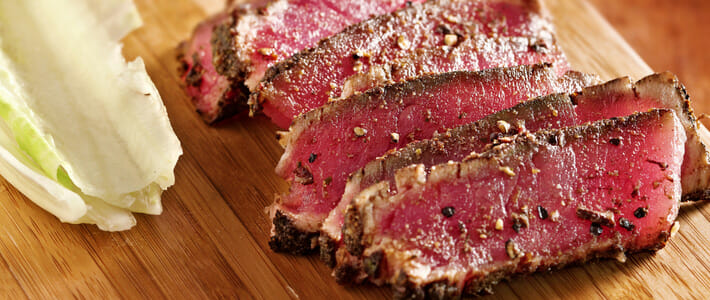Tuna, Yellowfin
Thunnus albacares

The yellowfin is a beautiful fish, named for its bright yellow dorsal and anal fins and the yellow stripe along its sides. Its average weight is 20 to 100 pounds. Tunas that are smaller than 40-50 pounds are called “footballs.” Cooked meat is grayish tan.
Tunas are graded as #1, #2+, #2 and grill grades with most of the #1 grade tuna going to Japan. Grading is done by inserting a hollow probe into the flesh of the fish, then pulling out a section to determine meat color and fat content. The redder the meat and the higher the fat content, the higher the grade. The second most abundant tuna, yellowfin is leaner and less expensive than bluefin and big eye tuna.
Product pdf for download-
3.5 oz (100g) raw edible portion
-
Calories 124
-
Calories from fat 0
-
Total Fat 2.5g
-
Saturated Fat 0.6g
-
Cholesterol 45mg
-
Sodium 37mg
-
Carbohydrates 0g
-
Protein 23.8g
-
Potassium 444mg
Interesting Fact
Yellowfin tuna are powerful fighters. When hooked, they run hard and deep and circle the boat to the end of the fight.
Alternatives
Bluefin tuna, big eye tuna, albacore tuna, and swordfish can be substituted for yellowfin.
Source
Yellowfins are found in tropical and subtropical regions of the eastern and western Pacific Ocean and in the Atlantic Ocean.
Harvest Method
Yellowfins are most often netted or longlined. Yellowfins from the Far East and Canada are all caught by longliners.
Harvest Season
Yellowfin is available year round with peak season during the summer months.
Flavor
Yellowfin tuna meat is moderate and distinct.
Texture
Firm with a large flake.
Preparation
Yellowfin tuna can be broiled or grilled.
Quality Control
Like other tuna, fresh yellowfin may contain bacteria that cause scombroid poisoning in humans. This can be avoided if fresh tuna is butchered and chilled immediately upon landing.
Market Segments
Yellowfin is appropriate in the casual dining, fine dining, hotel, and resort/club segments of the market.